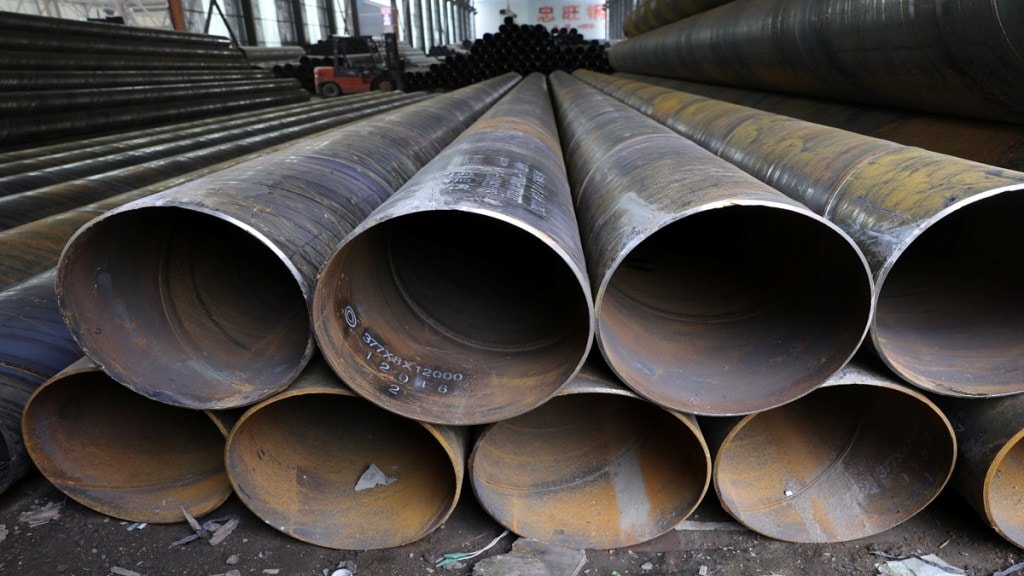The government may impose a hefty 30% duty on low-grade iron ore exports by October to ensure an uninterrupted supply of the key raw material for steel companies, at lower prices, and promote value-added exports.
The move, according to official sources, is part of a larger plan to support and strengthen the domestic steel industry, enabling it to export 50 million tonnes (MT) of finished steel at a competitive price within a short time frame.
India, the world’s second-largest steel-producing country, was a net importer of steel, mainly due to unbridled and cheap imports from China and Japan. The prohibitive tariff the US imposed on India may not have much impact on the cpuntry’s steel exports since the US accounts for only 3% of India’s total 5 MT kitty last fiscal, a decadal low.
Still, domestic mills are worried about potential predatory dumping of steel in India that touched a 10-year high of 9.5 MT last fiscal. The government aims to expand and diversify the steel industry’s export destinations, rendering the US tariff a non-issue.
Balancing steel industry demand and ore surplus
Steel making requires coking coal and iron ore, the two most critical raw materials. India largely depends on imports to meet its coking coal requirement. However, India’s sufficient iron ore reserves provide some competitive advantage to the domestic steel makers compared to their peers in China and Japan. Iron ore prices are on the higher side now. State-run NMDC, the country’s largest iron ore producer, raised prices by Rs 400 per tonne in August to Rs 5,250 a tonne for fines and Rs 6,100 a tonne for lumps.
At an inter-ministerial meeting also attended by representatives from industry and industry associations recently, it was decided that every effort would be made to supply iron ore at half the current price to the steel industry, ensuring their end products remain competitive in export markets. A source present at the meeting stated that the government aims to increase iron ore production, and more iron ore mines will be auctioned transparently and competitively, with strict penalties and action taken if a miner fails to produce the permissible quantity.
The government, however, seems not to be in favour of imposing a blanket ban on the exports of iron ore.
India exported around 30 MT of iron ore last fiscal, lower than the 48 MT exported in FY24. Most of the exports were fines or low-grade ores, which attract nil duty. China, the world’s leading steel producer, buys the lion’s share of the iron ore India exports.
Iron ore of higher grades – lumps – attracts a 30% export duty. But their share in the export basket is minimal as domestic steel mills use them for steelmaking.
Levying duty to rein in iron ore exports and to encourage value addition is not a new phenomenon in India; the government has employed this tactic repeatedly, only to reverse it in most cases.
In May 2022, India raised export duty on iron ore to 50% to meet rising local demand. However, six months later, in November, the the government scrapped the duty as exports came to a halt.
Mixed response from industry stakeholders
The proposed move, as expected, has brought cheers to the steel industry while the mining fraternity sulks, though it remained tight-lipped. The Federation of Indian Mineral Industries (FIMI) will soon submit a memorandum to the government, highlighting that there is no dearth of iron ore for domestic consumption, despite exports. Last fiscal year, there was a surplus of 14 MT, and in the current fiscal year, this is projected to increase to 35 MT, considering production rises to 320 MT in FY26, compared with 289 MT in the previous fiscal year.
Former SAIL Chairman and Chairman, Minerals and Metals Committee, PHDCCI, Anil Kumar Chaudhary, said, “To be competitive in the export market, the cost of manufacturing of domestic steel has to come down drastically. This is possible only when the prices of the two major raw materials required for steelmaking, namely iron ore and coking coal, can be stabilised. While it may be difficult to control the price of coal because of very high dependence on imports, efforts must be made to reduce the price of domestically produced iron ore.”
Chaudhary said this can be achieved through the beneficiation and pelletization of low-grade iron ore fines, which are currently being exported mainly to China, increase in export duty even for low-grade iron ore fines, having less than 58% iron content and thirdly, reduction in premium payable on IBM price, with appropriate change in statute and in consultation with the state governments, for production of iron ore through auctioned mines.
Abhinav Sengupta, a mining sector professional, however, said, “If the government imposes a 30% duty on exports of low-grade iron ore, it risks creating low-grade gluts at mine heads, squeezing state royalties, and inviting trade challenges while doing little to improve the higher-grade feed our steel plants actually needed. A rules-based, trigger-linked duty combined with a domestic supply obligation and a narrow carve-out for truly unabsorbable grades would protect steelmakers without destabilising miners. Make it time-bound and review it quarterly; that way we protect steel users today and build the higher-quality, lower-carbon feed our mills need tomorrow.”

